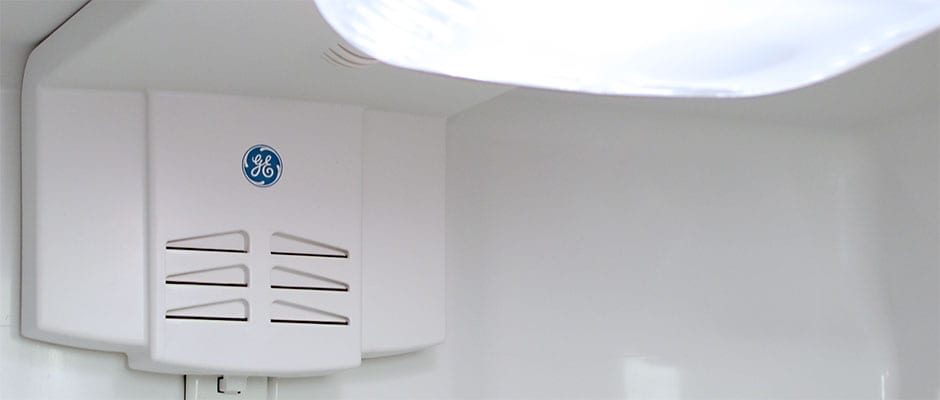Introduction
With great fridge temperatures, fantastic crispers, and a high level of energy efficiency, it's a mid-range fridge that actually offers performance that's on par with the price. You're getting more or less what you pay for here, which is a pretty darn good product... unless you're shopping for a household that subsists primarily on frozen veggies or microwavable pizzas.
Design & Usability
A take-it-or-leave-it approach to fridge customization.
Fresh out of the box, this GE is more or less what you'd expect for a low- to mid-range bottom freezer. It has white handles and a textured white finish. The temperature controls are vague, which comes as no surprise on a sub-$1500 fridge, though the knobs found on the bottom on the panel aren't the most user-friendly. Small fonts on a big panel make for a hard-to-read scale that's also hard to avoid.
Speaking of the fridge, the main section uses both half shelves—one of which has a deli drawer attached to it—and full-width shelves, but that's the only place where flexibility comes into play. The freezer has no adjustable components, which is par for the course on a pull-out, and even the crisper drawers have no adjustable controls. And unless your idea of flexible storage involves shelf removal, this fridge door is set for good.
Those shelves aren't even completely enclosed units, which means spills can likely drip through. Same goes for the freezer compartment's all-wire shelves. Fortunately, the fridge proper has some spill guards around the edges of its shelves for a small degree of protection.
{{photo_gallery "Front", "Fingerprints", "Handles", "Interior", "Fridge", "Crisper Drawer", "Fridge Door", "Freezer", "Freezer Door", "Side", "Back"}}
Performance & Features
Awesome at everything except fighting freezer burn.
We've grown used to fridges with nebulous controls that run a little warm. On this one, an arbitrary scale runs from zero to nine, with five as the suggested setting.
Much to our surprise, the "five" setting turned out to be pretty much spot on... for the fridge, anyway. Average temperatures from top to bottom stayed very close, and averaged almsot 37ºF exactly, our ideal for fresh food storage. Not only that, it was also consistent over time. There's very little that this fridge could have done better if it tried; we were very pleased.
Unfortunately, large temperature swings in some parts of the fridge went above and below the ideal 0ºF. That sort of behavior is a major contributing factor to freezer burn, which leads to food waste and lost money.
Like the fresh food compartment, the crisper drawers performed beautifully. They retained a ton of moisture, which should result in produce staying fresher and crisper for a longer period of time. Energy efficiency was excellent, though it's worth mentioning that you don't get an ice maker to run up the power cost. Like a Holiday Inn, GE did throw in a complementary ice bucket.
Conclusion
Farmer's market fans will love this fridge.
You'd think that with physics on its side, this GE bottom freezer would have a great chilling compartment, what with cold air falling and all. As we discovered, though, it was the cold storage that kept this product from earning a seat in our pantheon of fridges. Our specific concern was that, even when the thermostat was set to manufacturer-recommended settings, temperatures often swung above 0ºF and put foods at risk of freezer burn.
Despite the freezer issues and lack of customizable shelves, this fridge is better than many others in its price range. We liked its strong energy efficiency, decent storage space, and great fridge temperature output. If you can find it on sale—some retailers are offering it for as little as $949—it's not a bad deal at all.
The Cold Hard Facts
Almost all the results of our rigorous testing procedures indicate that the GE GBSC0HBXWW bottom freezer is a high-quality product. Unfortunately, the freezer dropped the ball here, exhibiting temperature fluctuations that kept this fridge from coming out on top. If your diet supports a mostly empty freezer, or if you eat frozen foods shortly after you buy them, definitely give this one a try. Take a look at our numbers, and you'll see why you should.
Temperature Performance
A perfect fridge with an overcompensating freezer.
Despite its vague controls and arbitrary cooling scale, the GE's fridge compartment was almost perfect. Average temperatures at the top were 37ºF exactly—out fresh food ideal—with only a small amount of cooling in the middle (36.53ºF) and a small amount of warming on the bottom (37.91ºF). Temperatures only shifted about 0.16 degrees over time, which makes this one of the most consistent fridges we've ever tested.
{{photo_gallery "Fridge Temperature", "Fridge Temp Graph"}}
Sad to say, we can't make that same claim about the freezer. Average temperatures were plenty cold—it got down to -1.81ºF at the top and -0.76ºF on the bottom-but the compartment couldn't maintain it. Temperature fluctuation averaged a whopping 1.1 degrees over time, which put some parts of the fridge on the fence above and below 0ºF on a regular basis. That sort of shifting leads to the development of freezer burn, a major flaw that can't be ignored.
{{photo_gallery "Freezer Temperature"}}
Moisture Retention
Crunchy carrots, crisp cauliflower...
Taking the lead from the fridge's temperature performance, the crispers in this GE turned out to be just as amazing. Over time, our test materials lost an average amount of 0.12 grams of moisture per hour. Given the fact that these drawers have no adjustable humidity control, we didn't expect quality results, but we were dead wrong. By that same token, refrigerated fruit doesn't necessarily have to retain as much moisture as vegetables, so such a high rate of moisture retention may not be ideal for grapes and strawberries.
Freezing & Thawing
A brisk start to things.
For all its consistency issues, there's no doubt that the GE's freezer gets cold. Our temperature sensors also proved that it does this quickly. Room temperature test materials were places in the bottom freezer, and in one hour and 22 minutes were officially frozen. That's about 15 minutes or so faster than average; now, if only GE could get the freezer to fluctuate less, that would make for a really effective freezing compartment.
{{photo_gallery "Freezing Graph"}}
In the other direction, we found that the insulation in the freezer was just as effective. Over the course of 36 hours without power, the freezer compartment effectively retained enough cold air that none of our test materials thawed out.
{{photo_gallery "Power Loss Graph"}}
Storage Space & Energy Efficiency
Ample room and long term savings.
Bottom freezers aren't known for being terribly spacious, but this GE manages to offer up a very reasonable amount of usable space. Two half shelves and two full shelves in the fridge make up the bulk of the storage space, with a deli drawer and two crispers to supplement. Additionally, the three shelves and single dairy bin on the door are quite spacious, regardless of their lack of customizability. In total, this impressive fridge compartment can hold up to 9.98 cubic feet of food, a fairly impressive number for a bottom freezer.
{{photo_gallery "Fridge Storage", "Fridge Door Storage"}}
Speaking of which, the literal bottom freezer is also pretty spacious... for its kind, anyway. The shelves and pull-out drawers in bottom freezers tend to take up a lot of room, though the lack of an ice maker means you get to use almost all the space that's left over. One shelf and a drawer comprise the majority of the storage space, with one lonely half shelf on the door giving you a nice spot for cold drinks, ice packs, or anything else you want to keep separate from the frozen meat and veggies. Those three spots total 3.91 cubic feet of usable storage; again, it's not huge, but it's pretty good for a bottom freezer.
{{photo_gallery "Freezer Storage", "Freezer Door Storage"}}
Ending on a high note, this GE was exceptionally energy efficient. One year of power for this machine will cost $39.37 based on a rate of $0.09 per kWh. It's not the cheapest we've seen, but it's even farther from the most expensive. Given the decent amount of storage, that translates into just 0.09 kWh per cubic foot of usable space. Again, it's not the most efficient we've ever seen, but it's still very, very good.
{{photo_gallery "Power Data"}}
Meet the tester
Matthew is a native of Brockton, MA and a graduate of Northeastern, where he earned a degree in English and Theatre. He has also studied at the Gaiety School of Acting in Dublin and spends most of his free time pursuing a performance career in the greater Boston area.
Checking our work.
Our team is here to help you buy the best stuff and love what you own. Our writers, editors, and experts obsess over the products we cover to make sure you're confident and satisfied. Have a different opinion about something we recommend? Email us and we'll compare notes.
Shoot us an email

